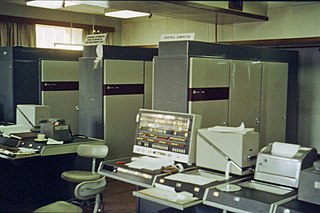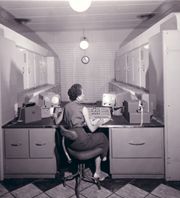 W
WThe Atlas Computer was one of the world's first supercomputers, in use from 1962 until 1971. It was considered to be the most powerful computer in the world at that time. Atlas' capacity promoted the saying that when it went offline, half of the United Kingdom's computer capacity was lost. It is notable for being the first machine with virtual memory using paging techniques; this approach quickly spread, and is now ubiquitous.
 W
WDATAR, short for Digital Automated Tracking and Resolving, was a pioneering computerized battlefield information system. DATAR combined the data from all of the sensors in a naval task force into a single "overall view" that was then transmitted back to all of the ships and displayed on plan-position indicators similar to radar displays. Commanders could then see information from everywhere, not just their own ship's sensors.
 W
WThe Ferranti Mark 1, also known as the Manchester Electronic Computer in its sales literature, and thus sometimes called the Manchester Ferranti, was produced by British electrical engineering firm Ferranti Ltd. It was the world's first commercially available general-purpose digital computer. It was "the tidied up and commercialised version of the Manchester Mark I". The first machine was delivered to the Victoria University of Manchester in February 1951 ahead of the UNIVAC I, which was sold to the United States Census Bureau on 31 March 1951, although not delivered until late December the following year.
 W
WThe Ferranti Market Research Terminal (MRT) was, arguably, the world’s first application-specific handheld computer. It was designed specifically for the market research sector as a means to augment the regular clipboard schemes that, at the time, were common-place, in social and market research. Despite having an appearance of a calculator built into a clipboard, the reality was that the unit contained a sophisticated form of programmable data-logger that, in response to an interviewer reading questions to the interviewee, had answers digitally recorded via pressing appropriate keys on the unit. The unit contained a bespoke operating system to support field based market research. The Ferranti Market Research Terminal (MRT) is also of historical significance to the computing industry since it marked the last original computer design from Ferranti, a long established business that had risen to fame through a collaboration Manchester University to produce the "Mark 1", the world’s first commercial computer and later with Cambridge University producing the "Atlas" and "Titan" computers which, at their peak, held around 25% of the computing market.
 W
WThe Nimrod, built in the United Kingdom by Ferranti for the 1951 Festival of Britain, was an early computer custom-built to play Nim, inspired by the earlier Nimatron. The twelve-by-nine-by-five-foot (3.7-by-2.7-by-1.5-meter) computer, designed by John Makepeace Bennett and built by engineer Raymond Stuart-Williams, allowed exhibition attendees to play a game of Nim against an artificial intelligence. The player pressed buttons on a raised panel corresponding with lights on the machine to select their moves, and the Nimrod moved afterward, with its calculations represented by more lights. The speed of the Nimrod's calculations could be reduced to allow the presenter to demonstrate exactly what the computer was doing, with more lights showing the state of the calculations. The Nimrod was intended to demonstrate Ferranti's computer design and programming skills rather than to entertain, though Festival attendees were more interested in playing the game than the logic behind it. After its initial exhibition in May, the Nimrod was shown for three weeks in October 1951 at the Berlin Industrial Show before being dismantled.
 W
WPegasus was an early British vacuum tube (valve) computer built by Ferranti, Ltd that pioneered design features to make life easier for both engineers and programmers. Originally it was named the Ferranti Package Computer as its hardware design followed that of the Elliott 401 with modular plug-in packages. Much of the development was the product of three men: W.S. (Bill) Elliott (hardware); Christopher Strachey (software) and Bernard Swann. It was Ferranti's most popular valve computer with 38 being sold. The first Pegasus was delivered in 1956 and the last was delivered in 1959. Ferranti received funding for the development from the National Research Development Corporation (NRDC).
 W
WTitan was the prototype of the Atlas 2 computer developed by Ferranti and the University of Cambridge Mathematical Laboratory in Cambridge, England. It was designed starting in 1963, and in operation from 1964 to 1973.